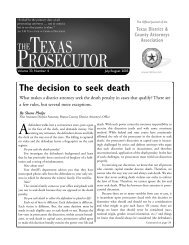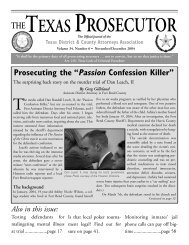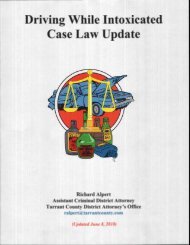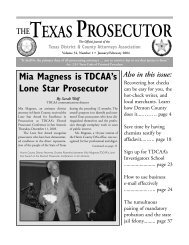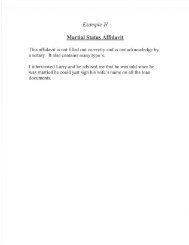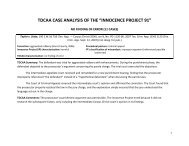Driving While Intoxicated Case Law Update - Texas District ...
Driving While Intoxicated Case Law Update - Texas District ...
Driving While Intoxicated Case Law Update - Texas District ...
You also want an ePaper? Increase the reach of your titles
YUMPU automatically turns print PDFs into web optimized ePapers that Google loves.
occur) who observed the traffic offense, radioed the information to the police and stayed in radio<br />
contact with the police up to the stop. ln effect, the sheriff's participation in the circumstances<br />
surrounding the defendant's arrest made him just as much a participant in the anest as ff he had<br />
seized the defendant himself.<br />
(c) HOT PURSUIT<br />
Yeaqer v. State, 104 S.W.3d 103 (Tex.Crim.App.2003).<br />
After observing the defendant nearly drive his vehicle into a ditch while leaving the parking lot of<br />
a bar within their city limits, officers followed him to further evaluate his driving and ultimately pulled<br />
him over for investigation of DWI outside the city limits. They stopped him after they obserued him<br />
almost hit another vehicle. The trial court held sfop was legal and the Court of Appeals reversed<br />
holding that the officers' "Type B Municipality" authority ended at the ctty 4imits, and it further<br />
rejected the "hot pursuit" argument as it found that there was no "chase" or "pursuit" as officers<br />
merely followed the defendant. The Court of Criminal Appeals found that this was a good example<br />
of "Hot Pursuit" and the dictionary definition of "pursuit" includes "follow." The test is whether the<br />
initial "pursuit" was lawfully initiated on the ground of suspicion, and the Court found in this case<br />
that it was. Ihe rssue of the jurisdiction of a "Type B Municipality" was not reached.<br />
Turnbow v. State,2OO3 WL 2006602 (Tex.App.-Fort Worth, May 1,2003, pet. ref'd.) (Not<br />
designated for. publication).<br />
Officer obserued defendant's vehicle speeding and cross over the center line five times. Though<br />
the officer tried to initiate the stop within the county line, by the time the defendant was pulled over,<br />
he was just under a mile across the line. The officer testified at a Motion fo Suppress hearing that<br />
he did not feel that he was involved in a chase or in a pursuit while he followed the defendant. The<br />
defendant was convicted at a later trial and argued on appeal that the arrest was illegal and not<br />
"hot pursuit." The Court of Appeals found that it was a legal stop under the "hot pursuit" doctrine<br />
and further found the doctrine applies even when an officer does not subjectively believe he is in<br />
hot pursuit.<br />
G. PRETEXT STOPS . NO LONGER BASIS FOR SUPPRESSION<br />
Crittendon v. State, 899 S.W.2d 668 (Tex.Crim.App. 1995).<br />
Pretext sfops are valid so long as objective basis for stop exrsfs.<br />
H. OPERATING VEHICLE IN UNSAFE CONDITION<br />
Sweeney v. State, 6 S.W.3d 670 (Tex.App.-Houston [1"tDist.] 1999, pet. ref'd.).<br />
State v. Kloecker, 939 S.W.2d 209 (Tex.App.-Houston [1st Dist.] 1997, no pet. h.).<br />
Trial judge held that there was insufficient basis for the stop. Court of Appeals reversed holding<br />
2t



